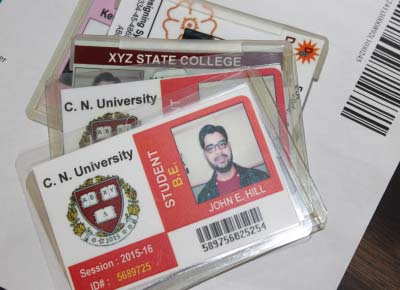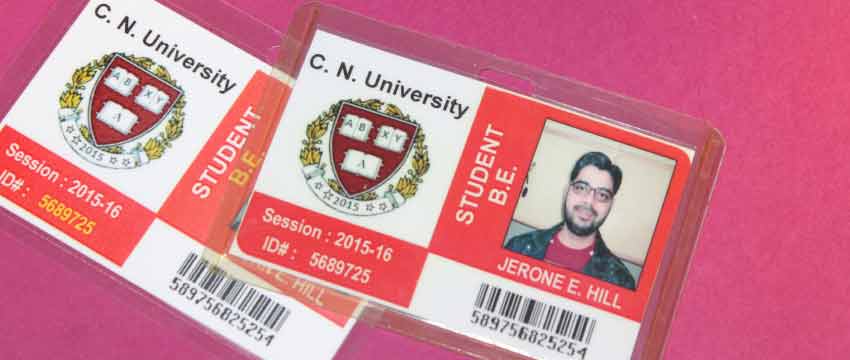Creating a Different Types of Student ID Cards for Different Programs or Departments
Yes, it is possible to create different types of student ID cards for different programs or departments within an educational institution. This can be achieved by implementing a system that allows for customization and differentiation based on the specific needs of each program or department. Here's a detailed explanation of how you can create different types of student ID cards:

-
Identify the requirements:
Start by understanding the unique requirements of each program or department. Consider factors such as access control, privileges, and specific information that needs to be displayed on the ID cards. For example, a science lab may require additional security features or access permissions compared to a general classroom.
-
Design the ID card template:
Create a basic ID card template that includes essential information such as the student's name, photo, unique ID number, and the name/logo of the educational institution. This template will serve as the foundation for creating different types of ID cards.
-
Customize the template:
Using the basic template, customize the design elements to reflect the program or department for which the ID card is being issued. This can include adding the program or department name, a unique color scheme, or a specific logo that represents the program.
-
Incorporate program-specific information:
Depending on the requirements of each program or department, you can include additional information on the ID cards. For example, a music program might have a section on the ID card that lists the student's chosen instrument, while a nursing program may include the student's specialization.
-
Security features and access control:
If certain programs or departments require enhanced security measures or access control, you can incorporate specific features into the ID cards. This can include barcodes, magnetic strips, or RFID chips that grant access to restricted areas or resources. These security features can be customized based on the needs of each program or department.
-
Printing and issuance:
Once the ID card templates have been customized for each program or department, they can be printed and issued to the respective students. The printing process can be done in-house using card printers or outsourced to a professional printing service.
-
Database management:
It is crucial to maintain an organized database that links each student's ID card information to their program or department. This will enable efficient tracking and management of access privileges and other program-specific requirements associated with the ID cards.
-
Ongoing maintenance:
As programs or departments evolve or change, it's important to have a system in place for updating and maintaining the ID cards accordingly. Regularly review and update the ID card templates and associated database to ensure accurate information and appropriate access control.
By following these steps, you can create different types of student ID cards tailored to the specific programs or departments within your educational institution. This customization helps enhance security, improve access control, and provide a sense of identification and belonging to students within their respective programs or departments.
The Typical Turnaround Time for Creating Student ID Cards
The typical turnaround time for creating student ID cards can vary depending on several factors, such as the institution's processes, resources, and the number of students involved. While there is no universally fixed timeframe, I can provide you with a general overview of the process and the factors that influence the turnaround time.
Once the design is finalized, the institution needs to collect and verify the necessary data for each student. This usually involves gathering information like the student's full name, student ID or registration number, photograph, and any other required details. The time required for this step can vary depending on the number of students and the efficiency of the data collection process. It may involve coordination with different departments, such as admissions or student affairs.
The first step in creating student ID cards is designing the card layout and determining the necessary information to include. This typically involves deciding on the card's design elements, such as school logo, student's name, photo, ID number, and other relevant details. This stage may require input from the institution's administration, design team, or ID card service provider. The time required for this step can vary based on the complexity of the design and the efficiency of the decision-making process.
After the data collection and verification process, the ID cards are typically printed and produced. The time required for this step depends on the number of cards to be printed, the printing technology used, and the availability of printing resources. Large institutions may have their own ID card production facilities, while smaller institutions may outsource this task to a printing service. Factors such as printer capacity, printing queue, and the complexity of the printing process can influence the turnaround time.
Once the ID cards are printed and ready, they need to be distributed to the students. This process may involve organizing a distribution event, mailing the cards, or distributing them through individual departments or administrative offices. Depending on the institution's logistics and the number of students, this step can take some time to ensure all students receive their ID cards. Additionally, if the cards require activation or linking to other systems (e.g., access control or library systems), this step may require additional coordination and time.
In some cases, there may be administrative processes or exceptions that can further affect the turnaround time for creating student ID cards. This could include scenarios like late enrollments, corrections or updates to student data, or reissuing cards for lost or damaged ones. Each exceptional case may require additional time and effort to address, potentially extending the overall turnaround time.
Incorporate School's Branding into the Student ID Card Design
Yes, it is common and often encouraged to incorporate your school's branding into the design of student ID cards. Doing so helps create a sense of identity and affiliation with the institution.

-
School Logo:
Including the school's official logo is a fundamental way to incorporate branding. The logo represents the visual identity of the institution and is typically placed prominently on the ID card. It can be positioned at the top, bottom, or corner of the card, depending on the overall design layout. The logo should be displayed clearly and at a size that maintains its visibility and legibility.
-
Colors:
Using the school's official colors is another effective way to incorporate branding into the ID card design. These colors can be used for the card's background, borders, or text elements. By aligning with the school's color scheme, the ID card becomes visually cohesive with other school materials, such as brochures, websites, or official documents. Consistency in color usage helps reinforce the school's branding across various platforms.
-
Typography:
Consider incorporating the school's official font or a font that aligns with the institution's branding guidelines. Typography plays a significant role in conveying the overall aesthetic and tone of the ID card. By using the school's designated font, the card's design maintains consistency with other school materials, creating a unified and recognizable brand identity.
-
Mascots or Symbols:
If your school has a mascot or specific symbols associated with its brand, you can incorporate them into the ID card design. This could include featuring the school mascot alongside the student's photo or incorporating smaller symbols that represent the institution's values or achievements. Including these elements adds a personalized touch and strengthens the connection between the student and the school.
-
Tagline or Motto:
If your school has a tagline or motto that encapsulates its mission or values, you can include it on the ID card. Placing the tagline or motto in a prominent location, such as below the school logo or on the back of the card, can reinforce the school's messaging and create a sense of pride among students.
-
Visual Elements:
Consider incorporating additional visual elements that are associated with your school's branding. This could include patterns, icons, or graphics that are unique to the institution. For example, if your school is known for its architecture or landmarks, you could include illustrations or photographs of these elements in the card design.